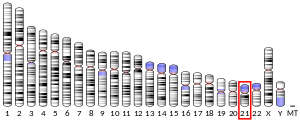|
KCNJ15
Potassium inwardly-rectifying channel, subfamily J, member 15, also known as KCNJ15 is a human gene, which encodes the Kir4.2 protein.[5] FunctionPotassium channels are present in most mammalian cells, where they participate in a wide range of physiologic responses. Kir4.2 is an integral membrane protein and inward-rectifier type potassium channel. Kir4.2 has a greater tendency to allow potassium to flow into a cell rather than out of a cell. Three transcript variants encoding the same protein have been found for this gene.[5] The existing literature describing KCNJ15 and Kir4.2 is sparse. In spite of some initial channel nomenclature confusion, in which the gene was referred to as Kir1.3[6] the channel was first cloned from human kidney by Shuck and coworkers in 1997.[7] Shortly thereafter it was shown that mutation of an extracellular lysine residue resulted in 6-fold increase in K+ current.[8] Two years later, in 1999, voltage clamp measurements in xenopus oocytes found that intracellular acidification decreased the potassium current of Kir4.2. Also activation of protein kinase C decreased the current although in a non-reversible fashion. Furthermore, it was found that coexpression with related potassium channel Kir5.1, changed these results somewhat, which the authors concluded was likely to be a result of heterodimerization.[6] Further voltage clamp investigations found the exact pH sensitivity (pKa = 7.1), open probability (high) and conductance of ~25 pS.[9] In 2007 the channel was found to interact with the Calcium-sensing receptor in human kidney, using a yeast-two-hybrid system. This co-localization was verified at the protein level using both immunofluorescence techniques and coimmunoprecipitation of Kir4.2 and the Calcium-sensing receptor.[10] Also a mutational study of Kir4.2 has demonstrated that removal of a c-terminal tyrosine increased the K+ current more than 10-fold.[11] Because the channel has a very high open probability, the authors of this last article conclude that this increase is mediated by increased trafficking of the protein to the membrane and not increased single-channel conductance. This same line of reasoning is applicable to the initial work of Derst and coworkers.[8] InteractionsKCNJ15 has been shown to interact with Interleukin 16.[12] See alsoReferences
This article incorporates text from the United States National Library of Medicine, which is in the public domain. |





